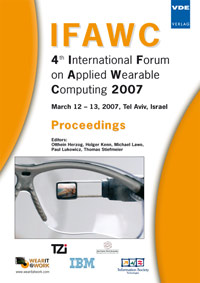A Model-based approach for designing Physical User Interfaces for Industrial Environments
Conference: IFAWC 2007 - 4th International Forum on Applied Wearable Computing 2007
03/12/2007 - 03/13/2007 at Tel Aviv, Israel
Proceedings: IFAWC 2007
Pages: 12Language: englishTyp: PDF
Personal VDE Members are entitled to a 10% discount on this title
Authors:
Kirisci, Pierre T.; Thoben, Klaus-Dieter (Bremen Institute for Industrial Technology and Applied Work Science at the University of Bremen (BIBA), Hochschulring-20, 28359 Bremen, Germany)
Abstract:
During the past decades much work has been done for establishing tools and techniques that support the design of software user interfaces such as GUI’s (Graphical User Interfaces). As software user interfaces seemed to adapt continuously to requirements, the interaction techniques of physical user interfaces (e.g. desktop PC, Notebook, PDA) principally remained the same. Moreover, physical user interfaces have been disregarded when speaking about user interface design in general. It is therefore not surprising that the methodologies used for physical user interface design are rather non-formal. This makes it complicated to sufficiently incorporate e.g. tasks, interactions and preferences of the user during the design process. As a result, contemporary physical user interfaces such as PDA’s, Smartphones and Notebooks are far from being adequate for supporting the user in his tasks the best possible way. This is especially true when considering the diversity of potential tasks and interactions of end users in industrial environments. Due to this fact, the authors of this paper are convinced that there exists a need for highly-specialised- and adaptive physical user interfaces. These new user interfaces can only turn out to be truly useful when appropriate methods are applied which are able to incorporate the specific context of the end user and of the environment during the entire design process. The authors of this paper invoke that model-based techniques have proven to be a well-established approach when it comes to designing useful software user interfaces. In analogy, it is argued that model-based techniques provide a promising approach when supporting the design of physical user interfaces such as wearable computing devices.


